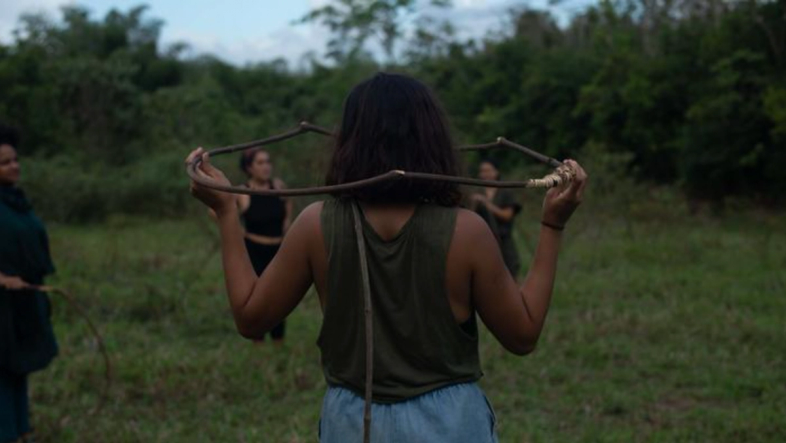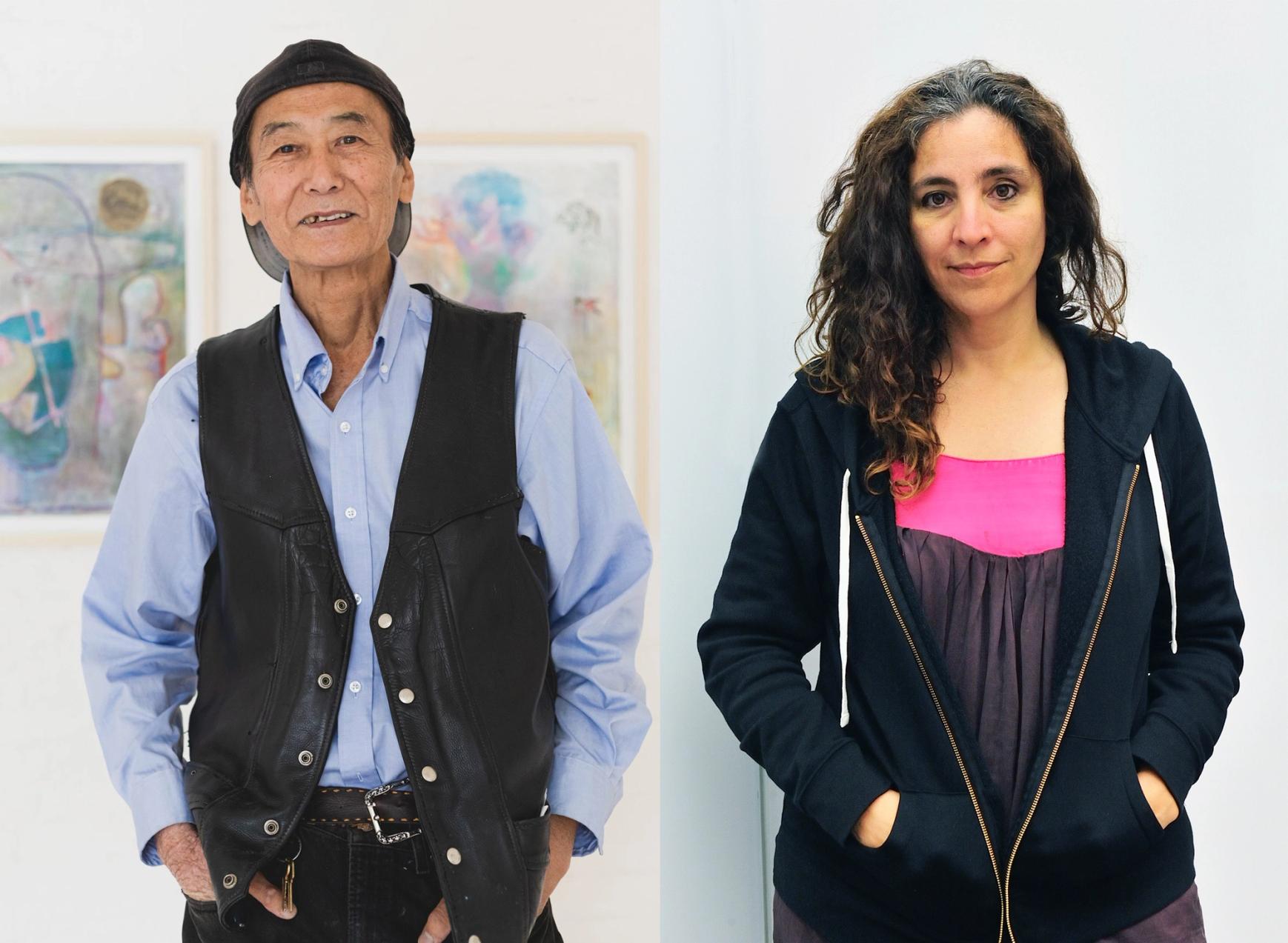
Rehearsals for Enactment: On Beatriz Santiago Muñoz’s Oriana
Oriana doesn’t aim to reflect the spectacle of the finished world, it invites us into a rehearsal toward the “what if” of a world imagined anew.
They write, of their authority to accord names, that it goes back so far that the origin of language itself may be considered an act of authority emanating from those who dominate.1
— Monique Wittig, Les Guérillères
In the first English edition of Monique Wittig’s 1969 novel Les Guérillères, the personal pronoun elles is translated as “the women.” This translation isn’t so simple, as the gender specificity of words in French doesn’t carry over into English, where words aren’t ascribed grammatical genders. Though “women” is indeed both feminine and plural, “the women” is etymologically at odds with Wittig’s linguistic intent: “woman” being a combination of “wife” and “man.”2 For a story set in the world after women have won a literal battle of the sexes, Wittig’s use of elles reflected that world shift of the narrative by going against the grain of French grammatical rules. Where ils is masculine and the default pronoun, elles, in Wittig’s work,asserts the feminine as the norm.3
Beatriz Santiago Muñoz first engaged with Wittig’s Les Guérillères in her 2016 video installation, That which identifies them, like the eye of the Cyclops, turning to it again in the performance, Mouther (2016/2019), and most extensively in the feature film Oriana (2022). Wittig’s book isn’t exactly the kind of text that lends itself well to a direct page-to-screen translation, and Muñoz’s projects don’t make the claim to be direct retellings of Wittig’s story. On one level, Wittig’s novel is a structural critique. Through a simple contradiction of grammar and pronouns, she proposes a systemic change: what if the orientation of power in the world were completely remade?
Oriana begins with a collective voice emerging out of darkness. They speak: “They say that in the beginning they are huddled against each other. They open their mouths to bleat or say something but no sound emerges.”4 Cut to them outside on the land. They crush organic matter into a red paint to mark themselves, inspect and collect plants and flowers, set fish traps. A single voice speaks: “They say that there is no reality until it has been given a shape by words rules regulations.” For Wittig, one of those “words rules regulations” was to be found in her choice of pronoun, which leaves me wondering where Santiago Muñoz locates the part of speech. Can an image make a gesture, one so simple and radical as shifting from ils to elles?
Wittig’s use of elles most significantly points to the binary of gender, but it is also entangled in the divide between singular and plural. Like Les Guérillères, Oriana largely eschews the linear progression of narrative and fundamental storytelling conventions: who, what, why, when, where. Clues suggest that they are in a tropical location, but nowhere specific. The film seems to take place after some undefined calamities—the novel’s battle against the patriarchy, as well as a hurricane, are referenced but never detailed. We see very closely this group of women, but unlike a traditional narrative in film, no one figure in the group presents any kind of articulation of a singular identity. For the most part, when we hear a voice, whether alone or in a group, its utterance comes in over the image; it is not spoken by any one character. And though they are not developed as characters in the traditional dramatic sense, they also don’t appear as an anonymized chorus but rather as a plurality of individuals. A multiplicity of selves.
Where many of the images in Oriana convey what Wittig can do with language, depicting the women in a series of actions and vignettes in the landscape, the film’s slippages into abstraction offer up one such gesture of articulating its own “words rules regulations.” In the film’s last chapter, the figurative imagery gives way to a series of leaky fields of light and color. Thick plumes of smoke, opaque liquid, and light, swirl into one another with the shimmer of stars. Here, reality is given shape. It’s celestial and cellular all at once, a visual embodiment of this commingling of the singular and the plural. Everything is both everything and nothing all at once.
If Santiago Muñoz’s engagement with Wittig’s book is neither retelling nor adaptation, what is it? As I keep culling through the thesaurus to try and come up with the right term, I wonder if it would be more useful to think of Oriana as an enactment. Santiago Muñoz’s film is not so much telling the story as it is doing it. Or practicing it. Perhaps in this way, Santiago Muñoz’s approach to Les Guérillères isn’t to look at it as story, but as score.
Santiago Muñoz has pointed to Brazilian theater artist, Augusto Boal, as an early influence on her practice. She speaks about how his work aimed to collapse the space between the performer and the viewer, noting: “I was attracted to Boal’s idea of both performers and audience having a choice about whether and how to intervene in what is happening. It’s also beautiful in terms of thinking about liveness: anybody who is present during the performance can change the space.”5
In Theatre of the Oppressed, Boal speaks of how, “the bourgeois theatre is the finished theatre. The bourgeoisie already knows what the world is like, their world, and is able to present images of this complete, finished world. The bourgeoisie presents the spectacle. On the other hand, the proletariat and the oppressed classes do not know yet what their world will be like; consequently their theatre will be the rehearsal.”6
In Oriana we watch the women doing. They make. They forage. They trap. They bathe. They rest. They mourn. They transform. But these scenes aren’t solely in service of a narrative or story. If Les Guérillères is a proposition toward a radically reoriented world, Oriana is a series of enactments of that proposition. Like the radical theater experiments of Boal, Oriana doesn’t aim to reflect the spectacle of the finished world, it invites us into a rehearsal toward the “what if” of a world imagined anew. In Oriana, that world is not just a speculative fantasy, it is also contained within—remembered within the bones, cells, and atoms of the women. “There was a time when you were not a slave. You know how to avoid the bear. You know how to hunt for rabbits which you skin for meat on the rocks. You have known fear of the hurricane. You say there are no words describe this era. But remember. And if you can’t remember invent.”7
NOTES
1 Monique Wittig, Les Guérillères (Paris: Les Éditions de Minuit, 1969). Translated from the French by David Le Vay (New York: The Viking Press, 1971), 112, 114.
2 Oxford English Dictionary, “woman (n.), Etymology,” March 2025, https://doi.org/10.1093/OED/7108165693.
3 In “The Mark of Gender,” Monique Wittig describes the use of the collective plural personal pronoun “elles” in Les Guérillères, as an attempt to “try to universalize the point of view of elles. The goal of this approach is not to feminize the world but to make the categories of sex obsolete in language.” Of the Le Vay’s translation into English, she notes that” the translator, lacking the lexical equivalent for elles, found himself compelled to make a change, which for me destroys the effect of the attempt. When elles is turned into the women the process of universalization is destroyed. All of a sudden, elles stopped being mankind. When one says ‘the women,’ one connotes a number of individual women, thus transforming the point of view entirely, by particularizing what I intended as a universal. Not only was my undertaking with the collective pronoun elles lost, but another word was introduced, the word women appearing obsessively throughout the text, and it is one of those gender-marked words mentioned earlier which I never use in French.... The solution for the English translation then is to reappropriate the collective pronounce they, which rightfully belongs to the feminine as well as to the masculine.” See Wittig, “The Mark of Gender,” Feminist Issues 5, no. 2 (June 1985): 3–12.
4 Beatriz Santiago Muñoz, Oriana, 2022. Single-channel HD video, color, sound, 78 min.
5 Beatriz Santiago Muñoz, interview by Andreas Petrossiants, “Destroy the Order Around You,” Frieze, no. 248 (December 2024), https://www.frieze.com/article/beatriz-santiago-Muñoz-andreas-petrossiants-248.
6 Augusto Boal, Theatre of the Oppressed, trans. Charles A. and Maria-Odilia Leal McBride and Emily Fryer(London: Pluto Press, 1979), 120.
7 Santiago Muñoz, Oriana.
Pablo de Ocampo is Director and Curator of Moving Image at the Walker Art Center in Minneapolis, Minnesota. From 2014 to 2020, de Ocampo was Exhibitions Curator at the artist-run center Western Front in Vancouver, Canada. His previous positions include Artistic Director of Toronto’s Images Festival from 2006 to 2014; co-founder/collective member of Cinema Project in Portland, Oregon; and programmer of the 59th Robert Flaherty Film Seminar, “History Is What’s Happening” in 2013. He currently serves as President of the Board of Trustees for the Flaherty Seminar. His writing has appeared in Canadian Art, C Magazine, BlackFlash, and in the catalogues Wendelien van Oldenborgh: unset on-set (Museum of Contemporary Art Tokyo), Dissident Lines: Lis Rhodes (Nottingham Contemporary), and Low Relief: Lucy Raven (EMPAC, Mousse, and Portikus).
